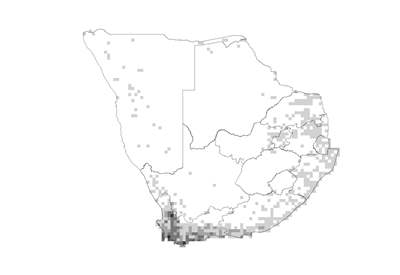 Species distribution and density. Darker squares represent higher density of members of this family. |
Introduction
Buchu family
The family is well known for its variety of citrus fruit but also has some very interesting and attractive representatives in southern Africa. Eleven genera, not resembling citrus fruit at all, are endemic to our area and mainly distributed in the Western Cape. All members of the family have oil glands in the leaves.
Distribution
Found in tropical areas in the southern hemisphere, with many endemic genera in South Africa and Australia. Locally, the highest concentration of endemic species is in the Western Cape, whilst the other species are more widespread in the northern, warmer summer-rainfall areas.
Number of genera in the world
160
Number of species in the world
1 650
Number of genera in the Flora of southern Africa region
21
Number of species in the Flora of southern Africa region
301
Well-known southern African genera
Acmadenia, Adenandra, Agathosma, Calodendrum, Macrostylis, Vepris, Zanthoxylum.
Growth forms
Mostly trees or shrubs.
Habitats
Mainly in fynbos but also in wooded and forest areas.
Flagship species
Calodendrum capensis (Cape chestnut; wildekastaiing [A]; umBhaba [Z]) is a deciduous to semi-deciduous tree with large opposite, gland-dotted leaves, which bears large clusters of pink flowers. Flowers have sterile stamens that are petal-like and marked with prominent dark pinkish or reddish glands. Fruit capsules are warted, splitting into 5 segments and releasing large black seeds. When in flower it stands out on wooded ridges and in kloofs and can easily be spotted from a distance. It is also widely planted in gardens as it grows easily from seed and has a non-aggressive root system. The wood is light-coloured and often used for furniture, turning and shelving.
Significance of the family
Citrus fruit (e.g. oranges, lemons, limes, grapefruit) are widely cultivated in frost-free areas of the world. Essential oils and flavourants are extracted from several buchu species (e.g. Agathosma betulina). Buchu is also used in traditional medicine to treat indigestion and ailments of kidneys and the urinary tract and to make buchu brandy. Small knobwood (Zanthoxylum capense) is medicinally used for treatment of various aches and pains. Curry leaf (*Murraya koenigii) is an ingredient of Indian curries. Sichuan pepper (*Zanthoxylum piperitum) is used as a spice.
Diagnostic characters
Plants aromatic with secretory cavities. Leaves alternate, usually petiolate and dotted with glands . Petals mostly 5 and free ; ovary superior �. Fruits dehiscent or indehiscent capsules, drupes or berries (citrus fruit are classified as modified berries called a hesperidium ); in the indigenous members fruit are often deeply lobed and horned .
Did you know?
Brazil ranks first and produces about 21.2% of citrus fruit in the world, whilst South Africa ranks 11th with 1.6%.